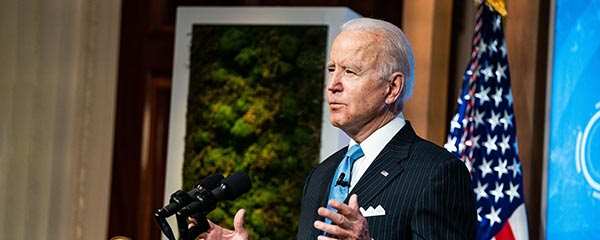The U.S. Census Bureau's announcement that the country's population grew 7.4% over the past decade to 331,449,281 may seem like significant growth -- but in reality, it represents the second-lowest decade-to-decade growth rate since the U.S. Census began in 1790, behind only the stagnant growth of the 1930s during the Great Depression.
What are the implications of a slowing growth rate? We have seen many arguments historically that slowing growth could be a good thing. One may recall Paul Ehrlich's bestselling 1968 book, The Population Bomb -- which, according to some reports, "incited a worldwide fear of overpopulation," horrifying readers by arguing that because of population growth "hundreds of millions of people are going to starve to death." Indeed, by 1992, Gallup polling showed 68% of Americans were worried about a great increase in population, although worry fell back to 48% by 1999, the last time Gallup asked about it. The worldwide calamities that Ehrlich predicted did not occur -- although in some countries today, there is too much growth, overburdening the ability to feed and employ the people within.
But there are now a number of countries around the world whose main population risk is undergrowth, or the negative implications of a population growth implosion. A United Nations report, according to the BBC, finds that "two-thirds of countries in Europe have introduced measures to increase fertility rates, from baby bonuses and tax incentives to paid parental leave." Italy is so concerned about its slowing growth rate that it has instituted schemes offering cash payments to couples who have babies. China, once so concerned about high population growth that it instituted a "one child policy," has now amended that policy as officials and scholars there express concern about the "looming crisis" of a shrinking population.
This same concern about slowing population growth is starting to show up in the U.S. Observers note that stagnant growth translates into a stagnant economy, with fewer workers and fewer customers for products and services. If "demographics are destiny," then the destiny of the U.S. may be changing for the worse, or so it is argued.
No one can predict with certainty the future trajectory of the U.S. population growth rate. While Americans' aging population points to future population decline, that could be offset by future political, medical and social factors that influence the key variables of births, deaths, immigration and emigration.
But, importantly for my interests here, there is an attitudinal component that affects these variables, and I'll look briefly at these in the sections that follow.
Having Babies
The birth rate, a key determinant of population growth, is strongly related to attitudes about having offspring, which itself reflects economic security, perceptions of the future, the availability of child care, the popularity of marriage, workforce participation and generalized norms surrounding the benefits of having children.
The fertility rate in the U.S. -- defined as the number of births per 1,000 women aged 15 to 44 -- was 58.2 in 2019, down from 64.1 in 2010. We don't know, however, if this decline is a short-term or long-term phenomenon.
Demographers tell us that the Great Recession and the COVID-19 pandemic were proximate causes of reduced childbearing. It follows that a booming economy in the years ahead and a receding pandemic may result in a reversal of this path. The group of Americans who are in childbearing years, incorporating the large millennial generation, may be harboring a pent-up desire to have children -- which could manifest itself in more births in the years ahead as the impact of the pandemic recedes and as the economy improves. Or, the shift in desire to have children could be permanent. It will be years before it is clear how long-lasting the drop is.
We do know that Americans have historically evinced a positive attitude toward the concept of having children. Gallup has asked Americans off and on over the years about their interest in having children, and in 2013 researcher Joy Wilke and I concluded, "More than nine in 10 adults say they already have children, are planning to have children or wish that they had had children. The 5% of American adults who do not want children is virtually the same as the 4% found in 1990." More specifically, we found that "more than half of Americans between the ages of 18 and 40 have children, and another 40% do not currently, but hope to have children someday. Only 6% of Americans aged 18 to 40 do not have, and do not want to have, children."
In other words, the desire for children was still the norm in the U.S. as recently as eight years ago.
Further, Gallup data collected in 2018 showed that Americans continue to believe that large families constitute an ideal state of affairs. Americans, on average, peg the ideal number of children at 2.7 (well above the replacement rate), and the percentage saying that having three or more children is ideal has increased rather than decreased. Importantly, only 4% said that the ideal number of children for a family to have is zero or one. As Gallup researcher Lydia Saad put it, "Americans, including young people, still embrace the idea of multiple children making for an 'ideal' family."
Of course, these data reflect Americans' perceptions of an idealized state of affairs and not what individuals think might be best for themselves personally. But certainly, the results show the persistence of a generalized norm that having multiple children is optimal.
Along these lines, The New York Times in 2018 reported on the results of a survey asking young adults to explain, in their own words, why they had fewer children than they thought was ideal. The top five reasons were perceptions that child care was too expensive, views that children would take up too much time, worries about the economy, perceived inability to afford children and postponement because of financial instability. Other reasons included concerns about paid family leave, global instability and domestic politics. A key here is the degree to which these concerns are mitigable if and when the economy is perceived as robust and stable, when concerns about the pandemic fade, if optimism about the state of the world increases, and based on changes in social policy.
As one example, President Joe Biden has proposed spending $200 billion to provide free preschool for all children aged 3 to 4, an action that could -- in theory -- serve to alleviate concerns about the financial and practical impact of having children.
Some experts believe the birth rate will, in fact, recover. Wharton professor Mauro Guillen called the decline in the fertility rate a "temporary blip," arguing that young couples have in essence said, "Give me a rain check, I don't want the baby now because there's too much uncertainty." Guillen argues that "they don't cancel their plans to have babies for life" and predicts higher birth rates in the coming two years.
Attitudes and the Numbers of Deaths in the U.S.
Unlike the number of births, which is strongly affected by the attitudes of those in childbearing years, deaths are inevitable. But for population counts, timing matters, and research shows that "emotional vitality" and attitudes toward health, lifestyle, diet and mental wellbeing can all be related to longevity. If everyone lives longer, the country's population will be greater than if people die off at younger ages. In particular, population growth in the U.S. will be higher to the degree that older baby boomers are mentally and physically healthy.
The COVID-19 pandemic has sharply increased deaths beyond what would be normal, although the hope is that this phenomenon will rapidly become a thing of the past. In the long run, everything else being equal, the most significant factor in determining the number of deaths in the U.S. population is the underlying age structure, and with many baby boomers soon moving into their 80s, an increase in deaths is inevitable.
Immigration Policy Will be a Key Determinant of Population Growth
The level of immigration into the U.S. is a key determinant of population growth, for fairly obvious reasons. The more people that come into the country, the higher the rate of population growth.
In the broadest sense, the entire history of population growth in the U.S. reflects immigration patterns -- starting with the migration of Native Americans millennia ago and accelerating as immigrants in larger and larger numbers began to arrive on American shores beginning in the 1600s. More recently, a good deal of the population growth reflects waves of immigrants from Mexico, Central America, Asia, Africa and other regions. Immigration to the U.S., however, slowed dramatically in 2020, the result of government policies and the pandemic. But, as summarized by the Migration Policy Institute, "even prior to 2020, the immigrant population in the United States already had been growing at much slower rates than a decade ago."
Immigration depends on two primary factors: the desire of residents of other countries to move to the U.S. and the attitudes of U.S. citizens which in turn affect policy decisions affecting immigration.
There is little question that a lot of people would like to move to America. According to Gallup World Poll data, the U.S. is the most desired destination for those worldwide who want to migrate. (As Gallup CEO and Chairman Jim Clifton recently noted, Gallup's data translate into an estimate that 42 million residents of Latin America and the Caribbean would migrate permanently to the U.S. if they could.) In short, there is no shortage on the demand side of the equation.
What about America's response to this pent-up demand? Attitudes toward immigration appear to be, on balance, positive. Americans have the sixth-highest Migrant Acceptance Index score of any country in the world, according to Gallup's calculations, based on the public's attitudes about migrants already living in their country.
Additionally, Gallup's Mohamed Younis recently noted that Americans want more, not less, immigration for the first time in Gallup's polling history -- based on Gallup data showing that 34% of Americans want more immigration and 28% want immigration decreased, with the rest (36%) saying that immigration should remain at present levels.
And, as I pointed out in a summary of attitudes about immigration, "… 77% [of Americans] said that immigration is a good thing for the country today -- by one percentage point, the highest in this trend. Plus, new Gallup polling shows the percentage of Americans who are both dissatisfied with the level of immigration into this country and want less immigration is at its lowest point in Gallup's 20-year history of asking the question. These data suggest that Americans want their elected representatives to take into account the positive impact of immigration on the nation as well as its downsides and negatives."
The policies and actions of the erstwhile Trump administration were famously negative toward immigration, but all indications are that Biden's views of immigration are much more in tune with American public opinion, and that the number of immigrants, asylum seekers and refugees will increase in the months and years ahead. Biden is also pushing new legislation that will allow those immigrants now in the country without legal documentation to remain here under specified circumstances.
An Increase in Americans Saying They Want to Leave the U.S.
There is no formal count of the number of Americans who make the decision to leave the country and live overseas. Most of those who emigrate from the U.S. remain American citizens, but unless they are employed by the U.S. government, they are not counted in the U.S. Census, and, of course, are not of much help to the U.S. economy in terms of domestic employment or domestic consumption.
Interestingly, Gallup estimates that 16% of Americans would like to move permanently to another country, higher than in previous years. Gallup researchers suggest that this reflected a "Trump effect" and doubted that the attitudes would result in a mass exodus. There is a thriving industry of publications and guides for Americans who want to retire abroad for economic reasons, but even if large numbers of baby boomers do decide to become "expats" in the years ahead, it would probably have (at best) only a modest impact on U.S. population growth figures.
Bottom Line
Population growth in the U.S. over the next few years will, to a significant degree, be determined by the public's attitudes and opinions, particularly as translated into the desire among those of childbearing years to have children and the political pressure among those of all ages to allow more immigrants into the country. Although the debate on the implications of slowing U.S. population growth is not settled, there seems to be a growing consensus that increased growth would be healthy for the future of the country.




